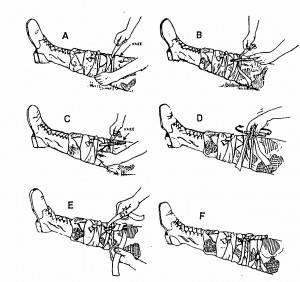Once the tourniquet is tightened, you must secure the rigid object so the tourniquet will not untwist.
a. Tourniquet Band Tails.
If the remaining tails of the tourniquet band are long enough, use them to secure the rigid object.
(1) Align the rigid object lengthwise (parallel) with the limb.
(2) Wrap one tail of the tourniquet band over and around one end of the rigid object (figure 2-24 E).
(3) Bring that tail down the side of the injured limb.
(4) Wrap the other tail of the tourniquet band over and around the other end of the rigid object.
(5) Bring that tail down the other side of the injured limb.
(6) Bring the tails together and tie them in a nonslip knot under the injured limb (figure 2-24 F).

b. Other Securing Materials.
If the tails are not long enough to secure the rigid object, use a cravat or strip of cloth to secure the object.
(1) Wrap the cravat or other piece of material around the limb below the level of the tourniquet band, but near enough to the tourniquet so the rigid object passes over the securing material. Wrap the material around the limb twice, if possible.
NOTE: The rigid object is secured below the tourniquet so the additional securing material will not interfere with blood circulation above the tourniquet.
(2) Align the rigid object lengthwise (parallel) with the limb.
(3) Wrap the material around the end of the rigid object so the rigid object is secured. This will prevent the tourniquet from unwinding.
(4) Tie the tails of the material in a non-slip knot.
